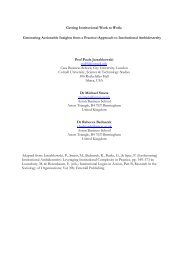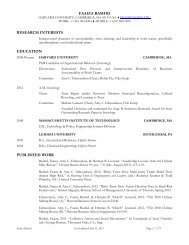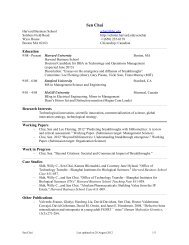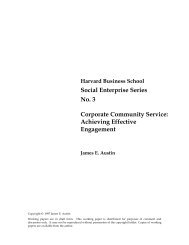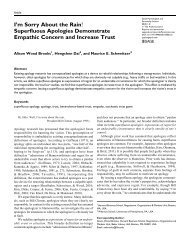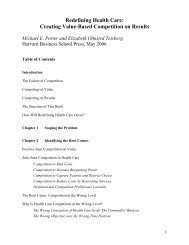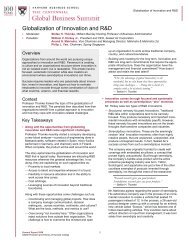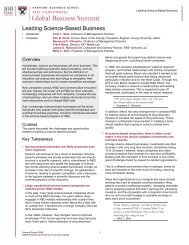Syllabus-Business 360
Syllabus-Business 360
Syllabus-Business 360
Create successful ePaper yourself
Turn your PDF publications into a flip-book with our unique Google optimized e-Paper software.
BUSINESS <strong>360</strong>˚<br />
—BUS500d<br />
Prof. Jan Barton<br />
Fall 2010<br />
Office hours: GBS 460, TTh 2:30–3:30 pm E-mail: jbarton@emory.edu<br />
Class hours: GBS 204, TTh 8:00–9:30 am, Phone: (404) 727.6398<br />
9:45–11:15 am, and 12:30–2:00 pm<br />
COURSE DESCRIPTION<br />
Goizueta’s intensive MBA core curriculum focuses on developing your analytical, technical and leadership<br />
skills through a series of foundational courses in the business disciplines—accounting, economics,<br />
finance, information systems, operations management, marketing, organizational behavior and strategy.<br />
By breaking the whole into its parts, each of these courses trains you rigorously in the discipline’s intellectual<br />
history, language, concepts and methods essential for a successful career in business.<br />
As society becomes more complex, however, business problems are increasingly beyond the ability of any<br />
of these disciplines to address and solve adequately on its own. If you want to devise truly comprehensive<br />
and innovative solutions, you will have to view complex problems from different perspectives and<br />
integrate whatever insights you glean from these perspectives. That is where this course comes in—it will<br />
change the way you think about thinking.<br />
The focus of <strong>Business</strong> <strong>360</strong>º will be on helping you develop breadth of vision and an integrative mindset,<br />
rather than on teaching you specific solutions that—in a complex world—are typically highly contextspecific<br />
and not useful as templates to solve other problems. By stressing multiple perspectives on a realword<br />
problem and merging them into a holistic view, you will learn to welcome complexity and the ambiguity<br />
that comes along with it, think inclusively and integratively, strive for balance among perspectives,<br />
identify relevant knowledge (even if you don’t have it), and maintain intellectual flexibility and curiosity.<br />
COURSE OBJECTIVES<br />
By the end of this course, I expect you to:<br />
1. Identify business problems that span over more than one discipline and/or involve multiple<br />
types of stakeholders. During each class period, we will discuss and analyze a fairly complex recent,<br />
real-world case. As the course progresses, the cases will become increasingly complex and<br />
ambiguous.<br />
2. Identify various concepts, theories, assumptions, methods and tools that may be relevant in<br />
solving a particular business problem. You will draw on what you have learned in the other<br />
core courses, giving you the opportunity to consolidate knowledge.<br />
3. Shift deliberately among alternative perspectives and bring each to bear upon the resolution<br />
of a complex problem. The intellectual ability to consider a variety of perspectives will allow you<br />
to perceive the problem and its context more accurately, process information more systematically,<br />
and make decisions more efficiently. To this end, you will make connections between disciplines<br />
and theories, between practical problems and accumulated knowledge, and your incentives<br />
and assumptions and those of other stakeholders. Within your team, try to view each case<br />
from both rotating stakeholder and disciplinary views. In other words, in one case try to assume<br />
an investor/finance perspective, in another case try to assume a customer/marketing perspective.<br />
© 2010 Jan Barton<br />
Revised October 25, 2010
4. Think dialectically. You will reason systematically by placing side-by-side opposing ideas and<br />
you will view differences, tensions and conflicts between them as a natural feature of complex<br />
problem solving.<br />
5. Think holistically. You will think about the problem in each case as part of a broader, more<br />
complex system. By viewing the problem in its broadest context, you will be able to identify the<br />
(often-times nonlinear) relationship of parts to the whole. For each assigned case, you will draw<br />
mind maps to help you visualize the problem and to identify creative and effective solutions.<br />
6. Communicate competently. The terminology that you are learning in each of the other core<br />
courses is an efficient “short-hand” way in which experts in the discipline communicate with<br />
each other. However, it usually gets in the way of communicating with others outside that discipline.<br />
As a business leader, you must be able to translate the terminology and make it accessible<br />
to a broad set of stakeholders and business partners. As part of the course requirements, you will<br />
prepare formal presentations of your case analyses to a sophisticated audience with a diverse<br />
background.<br />
7. Cultivate personal qualities for successful business leadership. These include the ability to take<br />
well-calculated risks to devise creative solutions; the ability to learn and adapt to the ambiguity<br />
that is so much a fact in life; the ability to reflect on the way you think, your assumptions and<br />
your biases; an appreciation of social and intellectual diversity; and humility—particularly when<br />
it comes to knowing what you don’t know!<br />
8. Consider the social and ethical dimensions of business decision making. You will have the opportunity<br />
to discuss social and ethical issues present in most business contexts, and to balance<br />
these issues with economic aspects to arrive at a solution that you and others can live with.<br />
This syllabus describes a tentative plan for achieving the course’s objectives. I will share with you specific<br />
learning objectives for each class session as we go along.<br />
COURSE STRUCTURE<br />
The course format is a combination of case discussions, problem solving and real-time analysis. We will<br />
engage in rigorous analysis and critical thinking in every class period. To meet the course’s objectives,<br />
you will probably have to invest about 8–10 hours of serious and conscientious out-of-class preparation<br />
each week. I suggest that you spend a couple of hours reading the case materials before meeting with<br />
your team.<br />
ASSIGNMENTS<br />
These learning activities and assessments (shown with their weights on your final grade) should help you<br />
achieve the objectives of the course:<br />
• Deck of slides for two cases @ 10% each 20%<br />
• Mind maps for three cases @ 10% each 30<br />
• Presentation of final case 30<br />
• Reflection journal 10<br />
• Class participation 10<br />
100%<br />
GRADING<br />
Your final score is the weighted average (based on the above weights) of your scores in each assignment. I<br />
will rank everyone’s final scores and then, following GBS guidelines, I will assign a DS to roughly the top<br />
15% of the class, an HP to the following 35%, a PS to the next 35%, and an LP to the bottom 15%. Honor<br />
Code violations and exceptionally poor performance usually get an NC. I reserve the right to convert<br />
your final letter grade to a “pass/fail” grade.<br />
2
DECK OF SLIDES<br />
Your team must turn in a deck of slides for three cases, including the final one. The deck should not exceed<br />
20 slides. Make sure each slide is well designed, easy to understand, and informative. You might<br />
find these three books useful in creating slides and presentations: Slide:ology: The Art and Science of Creating<br />
Great Presentations, by Nancy Duarte (2008); Presentation Zen Design: Simple Design Principles and Techniques<br />
to Enhance Your Presentations, by Garr Reynolds (2009); and Why Most PowerPoint Presentations Suck,<br />
2nd edition, by Rick Altman (2009).<br />
MIND MAPS<br />
You must turn in mind maps for the three cases for which you are not preparing a deck of slides. The first<br />
map should be solo-authored, the other two can be coauthored with your team. The mind maps should<br />
be contained within a US letter-sized (8½” x 11”) sheet of paper. Make sure the mind map is welldesigned,<br />
easy to understand, and informative. The best book on mind mapping that I have come across<br />
is The Mind Map Book: How to Use Radiant Thinking to Maximize Your Brain's Untapped Potential, by Tony<br />
Buzan and Barry Buzan (1996).<br />
PRESENTATION OF CASES<br />
Every case will be presented by at least one team. At the start of the case discussion, your team may be<br />
called to assume this responsibility. Therefore, make sure to come prepared to present each of case.<br />
Schedule your presentation to run for approximately 45 minutes, and make sure to allow for class discussion<br />
during your presentation. You should present the case’s context, the question that needs to be answered<br />
or decided on, the conceptual issues involved, and your suggested approach for dealing with<br />
those issues.<br />
REFLECTION JOURNAL<br />
On the last day of class, you will turn in a two-page paper describing what you learned throughout this<br />
course and the MBA core about the way you think through business problems. Pay special attention to<br />
areas that you believe need improvement and what you think would be an effective way to make that<br />
improvement. There is no “right answer” for this paper. Please type up the pages (11 or 12pt., 1” margins,<br />
no less than 1.5 spacing) and stapled them in the top left corner (i.e., no paper clips or covers, since I will<br />
likely lose them).<br />
CLASS PARTICIPATION<br />
Class participation (including on the course's FirstClass conference) is important because it enhances everyone’s<br />
learning experience, including my own. We all want you to be a valuable class member, so feel<br />
free to ask questions about issues that you don’t quite understand, contribute ideas and insights, offer examples<br />
from your experience working in the “real world,” challenge others’ assumptions and analyses,<br />
and raise interesting directions for class discussion. The emphasis of your class participation should be on<br />
the quality of your contribution, not on the duration of your “air time.” Your classmates will evaluate the<br />
quality of your class participation; I retain the right to adjust final class participation grades.<br />
MATERIALS<br />
Cases:<br />
We will analyze several cases. You can buy them for about $30 at the course’s website on<br />
study.net (http://www.study.net/r_mat.asp?crs_id=30018336).<br />
Books:<br />
We will read and discuss three book. You can buy them directly at any bookstore. The books<br />
have digital versions that you can buy at Amazon.com’s Kindle store for about $25.<br />
Landmark: The Inside Story of America’s New Health-Care Law and What It Means for Us All, by<br />
The Washington Post, 2010<br />
3
Half the Sky: Turning Oppression into Opportunity for Women Worldwide, by Nicholas D. Kristof<br />
and Sheryl WuDunn, 2009<br />
Creating a World without Poverty: Social <strong>Business</strong> and the Future of Capitalism, by Muhammad<br />
Yunus, 2007<br />
Readings: I will post additional material on the course’s FirstClass conference. These will include corporate<br />
annual reports, proxy statements, financial analyst reports, and articles from the business<br />
and popular press. You should include in your case analyses any insights you pull from these<br />
readings.<br />
Visuals:<br />
I have listed a couple of links to images and videos available online that I think are useful in<br />
preparing some of the cases for class discussion. Please watch them before class.<br />
COLLEGIALITY<br />
You are my student, not my client. I take this to mean that you should expect me (1) to exercise my best<br />
professional and pedagogical judgment in selecting the most important and relevant content, (2) to design<br />
effective (though sometimes painful) learning experiences and assessments, (3) to provide a safe<br />
space for you to learn, (4) to help you out when you get stuck, and (5) to treat you kindly and fairly. If I<br />
don’t meet your expectations, let’s talk about it.<br />
By the same token, I expect you to try your best at getting the most out of the course. Make sure to be<br />
present—in mind and body—in all class sessions. Keep cell phones and computers turned off during<br />
class. Food? No one wants to smell it, so no eating in class, please. No late assignments either, unless you<br />
caught a funky contagious virus or you can prove you were involved in a credible emergency. And don’t<br />
do anything stupid when it comes to the Honor Code (I’m the Faculty Chair of the Honor Council…). In<br />
short, just play nice, be mindful, learn a lot and have fun!<br />
COURSE OUTLINE<br />
PART CLASS CASE<br />
I. INTRODUCTION TO INTEGRATIVE THINKING<br />
1 Should China switch to IFRS?<br />
2 What assumptions are investors making about Apple’s future—and how reasonable<br />
are they?<br />
II. PRACTICE IN INTEGRATIVE THINKING<br />
3 Should Gilead restructure its Access program?<br />
4 How much would you bid to redevelop the largest slum in Asia?<br />
5 Was it a good idea for Bank of America to buy Merrill Lynch?<br />
6 How will “Obamacare” affect Pitney Bowes’ employee heath care strategy?<br />
III. FINAL PROJECT<br />
7 Should CARE start a financial literacy program for its microcredit customers?<br />
4
DETAILED CLASS SCHEDULE AND ASSIGNMENTS<br />
CLASS/DATE<br />
CASE/ASSIGNMENTS<br />
1—Tue. 10/26<br />
GOALS:<br />
CONTEXT:<br />
TASK:<br />
CASE:<br />
DUE:<br />
Should China switch to IFRS?<br />
To discuss course objectives and requirements, mind mapping and systems thinking.<br />
To examine the regulation of capital markets from a standard setter’s point of view,<br />
while taking into consideration the potential costs and benefits of such regulation to<br />
different capital market participants.<br />
In 2005, China announced plans to converge with—but not adopt—international financial<br />
reporting standards (IFRS). The country’s financial reporting regime had already<br />
undergone significant reforms in the previous couple of decades, a period during<br />
which its economy became one of the largest in the world. Despite these changes,<br />
the enforcement of accounting standards remained week, the capital markets were<br />
relatively underdeveloped, and large state-owned firms dominated most sectors of<br />
the economy.<br />
Prepare a mind map of the issues you should consider in crafting a recommendation<br />
to Chinese regulators about whether or not to fully adopt IFRS<br />
“IFRS in China”<br />
Nothing<br />
2—Thu. 10/28<br />
GOALS:<br />
CONTEXT:<br />
TASK:<br />
What assumptions are investors making about Apple’s future—and how reasonable<br />
are they?<br />
To apply different valuation approaches to uncover assumptions built into a firm’s<br />
share price. To use publicly available information (e.g., financial reports, analysts’<br />
reports, stock prices, strategy and industry analyses) as bases for assumptions in a<br />
valuation analysis.<br />
In Spring 2010, Apple Inc. launched the iPad and, a few months later, its new iPhone<br />
4. Apple's strategy of shifting its core business into non-PC products had proven a<br />
smashing success. Still, the business media continued to express concern about Apple’s<br />
ability to sustain its competitive advantage amid languishing Macintosh<br />
worldwide sales, lower growth in the iPod market, intense competition in the smartphone<br />
industry, and no clear succession strategy for its iconic CEO Steven Jobs.<br />
Through reverse engineering, identify a set of assumptions about Apple’s profitability,<br />
growth and riskiness that is consistent with the firm’s stock price. Assess the reasonableness<br />
of these assumptions. As the firm’s CFO, which assumptions would you<br />
be most concerned about? Why?<br />
CASE: “Apple Inc. in 2010”<br />
READINGS:<br />
DUE:<br />
Apple’s 2009 annual report<br />
Analyst reports on Apple by JPMorgan, Standard & Poor’s, and Argus<br />
Mind map<br />
***—Tue. 11/2<br />
CMC WEEK—No class<br />
***—Thu. 11/4<br />
CMC WEEK—No class<br />
5
3—Tue. 11/9<br />
GOALS:<br />
CONTEXT:<br />
TASK:<br />
CASE:<br />
READINGS:<br />
DUE:<br />
Should Gilead restructure its Access program?<br />
To evaluate the integration of a firm’s marketing, supply chain, and social responsibility<br />
strategies.<br />
Gilead Sciences, the U.S. leader in HIV/AIDS medicines, has undertaken several innovative<br />
actions to make its anti-viral products accessible in over 100 low- and middle-income<br />
countries. Management chose a target of reaching one million patients by<br />
end of 2009 and two million by 2012.<br />
Prepare an analysis of the changes, if any, that Gilead should consider making to its<br />
business model, and its Access program in particular, to ensure access to its products<br />
in the developing world<br />
“Gilead Sciences, Inc.: Access program”<br />
Gilead’s 2009 annual report and 10K<br />
“Expanding antiretroviral treatment coverage in the developing world,” by Gilead<br />
Sciences Inc., January 2010<br />
Deck of slides or mind map<br />
4—Thu. 11/11<br />
GOALS:<br />
CONTEXT:<br />
TASK:<br />
CASE:<br />
How much would you bid to redevelop the largest slum in Asia?<br />
To device a real estate investment strategy, by carefully assessing relevant revenues,<br />
construction costs, cost of capital and risks. To consider the social and ethical dimensions<br />
of business decision making. To evaluate one type of “bottom-of-the-pyramid”<br />
investment.<br />
In 2009, the Indian government began accepting bids to redevelop Dharavi, the largest<br />
slum in Asia, located in the middle of Mumbai. The bid requirements included<br />
providing new free housing to over half a million slum dwellers, which is expected<br />
to be paid for with the revenues from developing and selling market-rate housing.<br />
The $4.5 billion project had the potential to provide housing units worth over<br />
$150,000 each to the current slum residents, and to earn the investor group over $500<br />
million. If successful, such a private-state partnership could set a new paradigm in<br />
slum redevelopment around the world.<br />
Prepare a recommendation to Rance Hollen and Warwick Capital for whether to bid<br />
for the opportunity to redevelop Dharavi. Make sure to highlight and discuss the investment’s<br />
most important risks and how can they be mitigated.<br />
“Dharavi: Developing Asia’s largest slum”<br />
READINGS: “Mumbai’s shadow city,” by Mark Jacobson, National Geographic Magazine, 2007<br />
View:<br />
DUE:<br />
“The last frontier: Market creation in conflict zones, deep rural areas, and urban<br />
slums,” by Jamie L. Anderson, Constantinos Markides and Martin Kupp, California<br />
Management Review, 2010<br />
Images and videos in Google.com (i.e., search for “Dharavi”). These two videos are<br />
particularly interesting:<br />
http://www.youtube.com/watch?v=gYa6ooID1ZE&feature=related<br />
http://www.youtube.com/watch?v=EUMMq7B_DDs<br />
Deck of slides or mind map<br />
6
5—Tue. 11/16<br />
GOALS:<br />
CONTEXT:<br />
TASK:<br />
CASES:<br />
READINGS:<br />
DUE:<br />
Was it a good idea for Bank of America to buy Merrill Lynch?<br />
To examine the causes and consequences of the credit crisis of 2008. To analyze the<br />
annual reports and proxy statements of firms in the financial services industry. To<br />
evaluate the current competitive landscape in the banking industry.<br />
In September 2008, Bank of America offered to acquire Merrill Lynch to prevent the<br />
latter from going into bankruptcy. Initially, both BofA and Merrill viewed this acquisition<br />
favorably, but as Merrill’s losses ballooned and the U.S. government introduced<br />
programs like TARP to stave off a complete meltdown of the financial sector,<br />
BofA began having second thoughts about the deal with Merrill.<br />
Prepare an analysis of whether, considering the capital market/regulatory dynamics<br />
in late 2008 and the resulting shakeup in the financial services industry, it was a good<br />
idea for BofA to acquire Merrill Lynch. Where the terms of the acquisition, including<br />
BofA’s acceptance of TARP money, appropriate?<br />
“Bank of America acquires Merrill Lynch (A)”<br />
“Investment Banking in 2008 (A): Rise and Fall of the Bear”<br />
“Investment Banking in 2008 (B): A Brave New World”<br />
Merrill Lynch’s 2009 annual report<br />
Bank of America 2008 and 2009 annual reports<br />
Bank of America 2009 and 2010 proxy statements<br />
“10 Minutes on US financial reform,” by PricewaterhouseCoopers, July 2010<br />
Deck of slides or mind map<br />
6—Thu. 11/18<br />
GOALS:<br />
CONTEXT:<br />
TASK:<br />
CASE:<br />
READINGS:<br />
DUE:<br />
How will “Obamacare” affect Pitney Bowes’ employee health care strategy?<br />
To assess the most likely effects of government regulation on business behavior. To<br />
evaluate the major provisions of U.S. healthcare reform. To identify different components<br />
of employee compensation, health care and retirement benefits. To examine<br />
ways in which these components can promote employee health and increase shareholder<br />
wealth.<br />
U.S. employers face substantial direct costs (e.g., health insurance benefits) and indirect<br />
costs (e.g., absentism, lower productivity) of poor employee health. Instead of<br />
focusing on negotiating premium discounts or disengaging from employee health<br />
benefits altogether, Fortune 500 firm Pitney Bowes, widely regarded as an innovator<br />
in employee health care, takes a longer-term view of employee health care by creating<br />
a culture of workplace health, offering primary care and wellness programs.<br />
With the 2010 enactment of the Patient Protection and Affordable Care Act, Pitney<br />
Bowes will need to reconsider how to address employee health care to avoid unintended<br />
consequences from the new regulations.<br />
Prepare an analysis of the most likely effects of U.S. healthcare reform on Pitney<br />
Bowes’ employee health care programs. Include in your analysis a set of recommendations<br />
for Pitney Bowes to consider in optimizing these regulatory effects.<br />
“Pitney Bowes: Employer Health Strategy”<br />
Landmark: The Inside Story of America’s New Health-Care Law and What It Means for Us<br />
All, by The Washington Post, 2010<br />
“Health care reform: Employee benefits considerations for CFOs,” Deloitte CFO Insights,<br />
2010<br />
“Health care reform: What is your timeline?,” Deloitte CFO Insights, 2010<br />
Deck of slides or mind map<br />
7
***—Tue. 11/23<br />
THANKSGIVING WEEK—No class<br />
***—Thu. 11/25<br />
THANKSGIVING WEEK—No class<br />
***—Tue. 11/30<br />
FINAL CASE PREPARATION TIME—No class<br />
7—Thu. 12/2<br />
GOALS:<br />
CONTEXT:<br />
TASK:<br />
CASE:<br />
READINGS:<br />
DUE:<br />
Should CARE start a financial literacy program for its microcredit customers?<br />
To review concepts, theories and tools learned throughout Goizueta’s MBA core<br />
courses.<br />
CARE USA, a large international nonprofit/NGO, has recently revamped its external<br />
branding and positioning to support its international development work. Included in<br />
this work is providing access to microcredit to the poor.<br />
Develop a business literacy program for recipients of CARE’s microcredit services.<br />
Pay close attention not only to the content of the program but also to its delivery.<br />
Make sure to identify the potential costs and benefits of such a program, and its direct<br />
and indirect fit with CARE’s overall business model and strategy.<br />
“Repositioning CARE USA”<br />
Creating a World without Poverty: Social <strong>Business</strong> and the Future of Capitalism, by<br />
Muhammad Yunus, 2007<br />
Half the Sky: Turning Oppression into Opportunity for Women Worldwide, by Nicholas D.<br />
Kristof and Sheryl WuDunn, 2009<br />
CARE USA’s 2010 annual report<br />
“Access Africa: Equal access to financial services,” by CARE, 2008<br />
“Rethinking microfinance: The Grameen II diaries,” Chapter 6 in Portfolios of the Poor:<br />
How the World's Poor Live on $2 a Day, by Daryl Collins, Jonathan Morduch, Stuart<br />
Rutherford and Orlanda Ruthven, 2009<br />
Final deck of slides and presentation<br />
8





